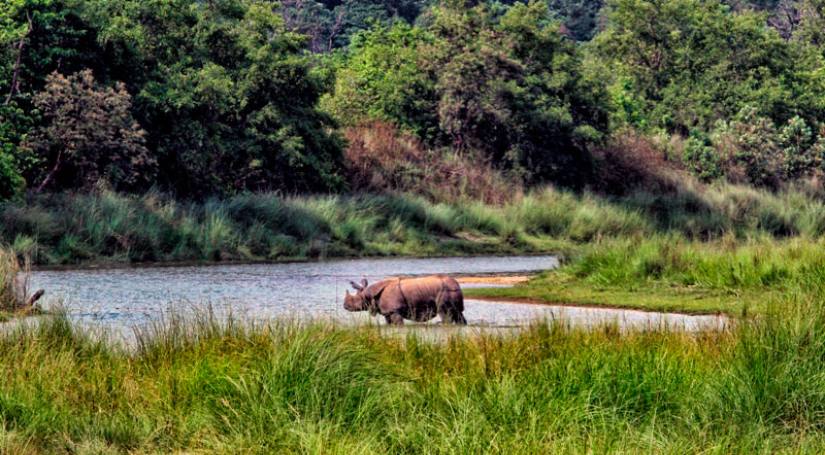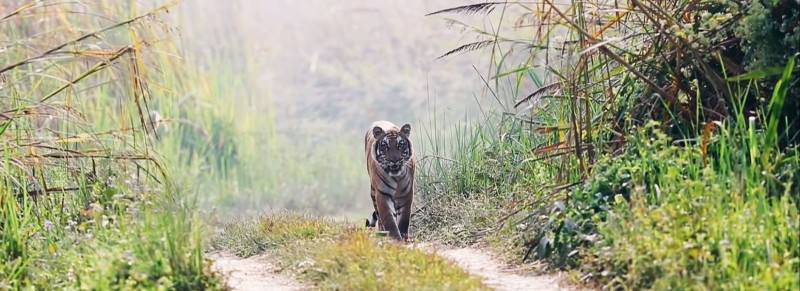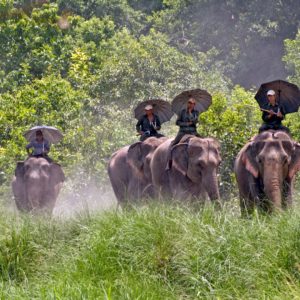
Trip Facts
-
- Duration
- 3 Days
-
- pax
- 1+
-
- Duration
Overview
Bardiya National Park is a protected area in Nepal that was established in 1988 as Royal Bardia National Park. Covering an area of 968 km2 (374 sq mi) it is the largest and most undisturbed national park in Nepal’s Terai, adjoining the eastern bank of the Karnali River and bisected by the Babai River in the Bardiya District. Its northern limits are demarcated by the crest of the Siwalik Hills. The Nepalgunj–Surkhet highway partly forms the southern boundary, but seriously disrupts the protected area. Natural boundaries to human settlements are formed in the west by the Geruwa, a branch of the Karnali River, and in the southeast by the Babai River.[1]
Together with the neighboring Banke National Park, the coherent protected area of 1,437 km2 (555 sq mi) represents the Tiger Conservation Unit (TCU) Bardia-Banke that extends over 2,231 km2 (861 sq mi) of alluvial grasslands and subtropical moist deciduous forests.
History
In 1815, Nepal lost this region to the East India Company through the Sugauli Treaty. For 45 years it was a part of British India and returned to Nepal in 1860 in recognition for supporting the suppression of the Indian Independence movement in 1857. Today, this annexed area is still called Naya Muluk meaning new country. An area of 368 km2 (142 sq mi) was set aside as Royal Hunting Reserve in 1969 and gazetted as Royal Karnali Wildlife Reserve in 1976. In 1982, it was proclaimed as Royal Bardia Wildlife Reserve and extended to include the Babai River Valley in 1984. Finally in 1988, the protected area was gazetted as national park.[1]
The approximately 1500 people who used to live in this valley have been resettled elsewhere. Since farming has ceased in the Babai Valley, the natural regenerated vegetation makes the area a prime habitat for wildlife.
Vegetation
About 70% of the park is covered with forest, with the balance a mixture of grassland, savannah and riverine forest.[4] The flora recorded in the park comprises 839 species of flora, including 173 vascular plant species comprising 140 dicots, 26 monocots, six fern, and one gymnosperm species
Fauna
The wide range of vegetation types in forest and grassland provides excellent habitat for 642 faunal species. The Karnali-Babai river system, their small tributaries and myriads of oxbow lakes is habitat for 125 recorded species of fish. A small population of gharial inhabits the rivers. Apart from the mugger crocodiles, 23 reptile and amphibian species have been recorded
Mammals
One-horned rhinoceros in Bardiya National Park
The Bardiya National Park is home to at least 53 mammals including greater one-horned rhinoceros, Indian elephant, Bengal tiger, barasingha, and Gangetic dolphin.[5] A rusty-spotted cat was sighted for the time in summer 2012.[6] A fishing cat was recorded in Babai River valley in winter 2017
Rhinoceros
Translocation of rhinos from Chitwan to Bardia National Park commenced in 1986, with 58 individuals relocated until 2000. From 1994 to 2000, hunters have been unsuccessful at poaching rhinos. In April 2000, there were 67 rhinos in the park, most of them resident in the Babai Valley.[8] In May 2006, a reconnaissance survey was carried out in the Babai River floodplain, which revealed an alarming decline in the rhino population. Poaching was suspected to be the main cause of this decline. Subsequent surveys in 2007 and 2008 have confirmed the complete disappearance of rhinos from Babai Valley. In different habitats of the Karnali floodplain 25 rhinos were recorded based on direct observation and indirect signs of rhino dung and tracks. They were mostly congregated in the floodplain grassland, riverine forest and wetlands.[9] In March 2008, only 22 rhinos were counted, and two of them were poached after the count.[10] The World Wide Fund for Nature reported that by 2015, the rhino population had risen to 29, mainly because of increased security measures
Elephants
In 1985, two large elephant bulls were spotted for the first time in the park, and named Raja Gaj and Kanchha. They roamed the park area together and made occasional visits to the females. Raja Gaj stood 3.4 m (11.3 ft) tall at the shoulder and had a massive body weight. His appearance has been compared to that of a mammoth due to his high bi-domed shaped head. His forehead and domes were more prominent than in other Asian bull elephants. In 1993, five elephants were seen entering the park, and one year later another 16 individuals arrived. A population count in summer 1997 revealed 41 resident individuals.[12] In 2002, more than 60 individuals were estimated to reside in the Karnali floodplain and the Babai Valley
Birds
Peacock displaying his plumes
Current checklists include 407 bird species, among them the Bengal florican, white-rumped vulture, peafowl, and bar-headed geese, which are symbolic of the park.[5] Lesser florican and sarus crane are present; grey-crowned prinia, jungle prinia, pale-footed bush warbler, aberrant bush warbler, striated grassbird, golden-headed cisticola and chestnut-capped babbler occur in the park’s grasslands
Trip highlights
- Elephant back Rides/ jeep safari
- Crocodile Breeding Center
- Exploration of Tiger territory
- Bird Watching
- Jungle walks
- Village tours
Trip introduction
The Bardia National Park also spelled Bardiya, is a protected area in Nepal that was established in 1988 as Royal Bardia National Park. Covering an area of 968 km 2 (374 sq mi) it is the largest and most undisturbed national park in Nepal’s Terai’s adjoining the eastern bank of the Karnali river and bisected by the Babai river in the Bardiya District . Its northern limits are demarcated by the crest of the Siwalik Hills. The Nepalgunj- Surkhet highway partly forms the southern boundary, but seriously disrupts the protected area.
Also about a 70% the park is covered by the forest, grassland, savannah and riverine forest. It is the home of 53 mammals. We could find rhinoceros, wild elephant, Bengal tiger, swamp deer, and Gangetic dolphin. Amost 407 species of birds are found here. The Bengal florican, white-rumped vulture, peafowl, and bar-headed geese are the main symbol attraction of the park.
This is the right place to explore around the nature which will take you to the exciting part of Tiger Tracking, Elephant Tracking, Jungle/Nature walk, Bird watching, wild sightseeing, Jeep safari, Dolphin sightseeing, Camping, Hiking, and many more.
Itinerary
Flight from Kathmandu to Nepalgunj which take about 40 minutes. On your arrival at Nepalgunj resort, staff will receive you. You will then be transferred to resort. On reaching resort, resort manager will brief you about your stay with your lunch. After that we will visit local village/ Elephant stable with other activity and then back to the resort. Overnight at resort
After breakfast we would go for jungle walk. Dugout cone ride with elephant back safari and full day guided Jungle Walk taking in various areas in the park and targeting different species of birds and animals. Then you can enjoy the traditional western Tharu dance then be back to resort. Overnight at Resort
Today after your breakfast we will drive back to Nepalgunj for our scheduled flight to Kathmandu. Depending on the flight time, we can spend some time visiting nearby places. Upon arrival in Kathmandu, you will be transferred to your hotel. Overnight in Kathmandu.
What is Includes
- Accommodation in the resort in twin sharing/double basis
- Hotel / pick up & drop by tourist vehicle
- Transfer from Kathmandu – Chitwan – Kathmandu by tourist vehicle with driver
- Guided tours and activities inside the Chitwan National Park
- Full board meals (breakfast, lunch and dinner) with hot drinks
- A government licensed English speaking safari guide during the trip
- All local permits and entrance fees
- All government taxes / tourist services charges / vat / official expenses
What is not Includes
- Travel insurance (recommended)
- International airfare to and from Nepal and visa
- Personal expenses
Any others expenses which are not mentioned on ‘Price Includes’ section
Cost and Dates
- Small Group Journey
- Private Journey
- Customize Trip
The set departure dates listed are specially quoted and specified for group joining option. Let us know if the set departure dates are not suitable for you- another dates which are suitable for you can certainly be added by uss.
Check Available Dates


